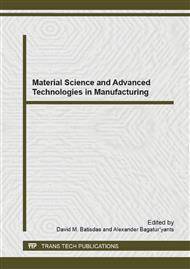[1]
M.A. MCCARTHY AND F.I. MEREDITH. Nutrient Data on Chestnuts Consumed in the United States. Economic Botany, 1988, 42(1),P. 29-36.
DOI: 10.1007/bf02859026
Google Scholar
[2]
Park E Y. Luh B S. Polyphnol oxidase of Kiwifruit[J].J. Food Sci. 1985. 50(3),P. 678-684.
Google Scholar
[3]
Mowlah G. Takono K. Kamoi I. Browning phenomenon by banana polyphenol oxidases[J].J. Japanese Society of Food Science and Technology. 1983. 30(4) ,P. 245-251.
DOI: 10.3136/nskkk1962.30.245
Google Scholar
[4]
Sciancale V. Longone V. Polyphenol oxidase activity and browning in green olives[J].J. Agric. Food Chem. 1984. 32,P. 320-321.
DOI: 10.1021/jf00122a035
Google Scholar
[5]
Van Loey, A.; Verachtert, B.; Hendrickx, M. Effects of high electric field pulses on enzymes. Trends Food Sci. Technol. 2002, 12,P. 94–102.
DOI: 10.1016/s0924-2244(01)00066-8
Google Scholar
[6]
Matsui, K. N.; Granado, L. M.; de Oliveira, P. V.; Tadini, C. C. Peroxidase and polyphenol oxidase thermal inactivation by microwaves in green coconut water simulated solutions. LWT 2007, 40,P. 852–859.
DOI: 10.1016/j.lwt.2006.03.019
Google Scholar
[7]
Biles, C. L.; Martyn, R. D. Peroxidase, polyphenoloxidase, and shikimate dehydrogenase isoenzymes in relation to tissue type, maturity and pathogen induction of watermelon seedlings. Plant Physiol. Biochem. 1993, 31,P. 499-506.
Google Scholar
[8]
Cao Jiankang, Jiang Weibo, Zhao Yumei, et al. The Experiment Instruction for Vegetables after physiological and biochemical (In Chinese) [M]. Beijing: Chinese light industry press, 2007,P. 62-65.
Google Scholar
[9]
Ye Xingqian, Zhang Guiping. A study on properties of polyphenol oxidase in chestnut kernel (In Chinese) [J]. Journal of Shanghai Jiaotong University (Agricultural Science ), 2001(19) ,P. 174-178.
Google Scholar
[10]
Cano, M. P.; Lobo, M. G.; De Ancos, B.; Galeazzi, A. M. Polyphenol oxidase from Spanish hermaphrodite and female papaya fruits (Carica papaya cv. Sunrise, Solo group). J. Agric. Food Chem. 1996, 44,P. 3075-3079.
DOI: 10.1021/jf960119k
Google Scholar
[11]
Schilling, S.; Schmid, S.; Jäger, H.; Ludwig, M.; Dietrich, H.; Toepfl, S.; Knorr, D.; Neidhart, S.; Schieber, A.; Carle, R., Comparative Study of Pulsed Electric Field and Thermal Processing of Apple Juice with Particular Consideration of Juice Quality and Enzyme Deactivation. Journal of Agricultural and Food Chemistry 2008, 56 (12) ,P. 4545-4554.
DOI: 10.1021/jf0732713
Google Scholar
[12]
Wang Shaolin. Microwave Food Engineering (In Chinese) [M]. Beijing: China Machine Press, 1994,P. 2-3.
Google Scholar


